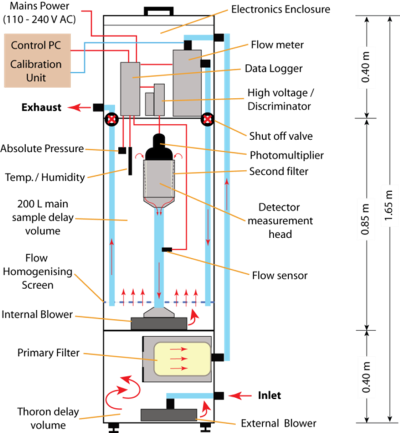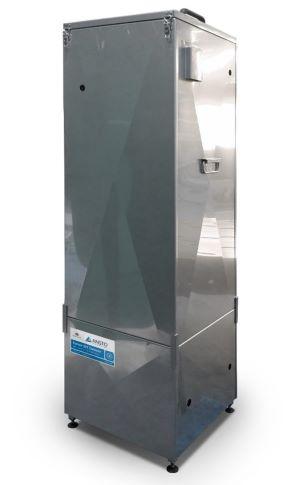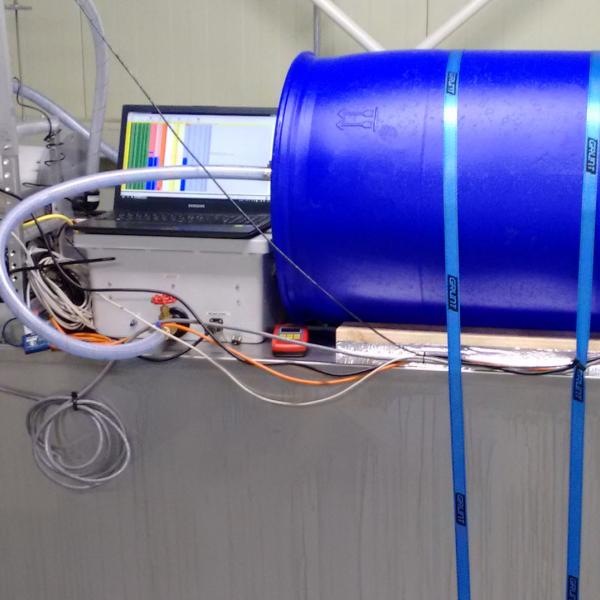

Published on the 5th May 2023 by ANSTO Staff
Key Points
-
ANSTO Scientists develop a 200 L, smaller and more transportable, version of ANSTO’s 1500-litre atmospheric radon-222 monitor
-
ANSTO Radon monitoring technology is used in over 30 locations around the world, but demand is growing
-
The new 200 L size will be ideally suited to buildings, where environmental authorities are monitoring radon concentrations
The need for a smaller, more transportable version of ANSTO’s 1500-litre atmospheric radon-222 monitor, and with a calibration traceable to the International System of Units, prompted the team to develop a 200-litre radon monitor that would meet those needs.
This world-leading dual-flow-loop two-filter ANSTO technology is used in over 30 locations around the world, but demand is growing as the need for a better understanding of the processes that drive urban air pollution and climate becomes more important.
Recognised by the World Meteorological Organisation as the best in the world for global and atmospheric compositional baseline studies, it is used by the International Atomic Energy Agency and leading environmental monitoring organisations around the world.
The ANSTO-designed radon monitors, that are made and serviced by environmental scientists, provide invaluable data on atmospheric mixing to support accurate monitoring of changing atmospheric conditions.
“Several years ago, we learned that a competitor had built a product that wasn’t as sensitive, but it was more portable and that spurred us to see if we could reduce the size,” explained environmental Atmospheric Physicist / Senior Researcher Dr Scott Chambers.
“With some funding support from the National Metrology Institute in Germany, who were interested in purchasing one of the new detectors as part of an international Trace Radon Project, we went ahead,” said Dr Chambers.
Using the same detection method but with a vertically oriented design, they were able to reduce the size from 3.0 metres by 1.7 metres by 0.9 m (4.6 m3) to 1.6 metres by 48 centimetres by 48 centimetres (0.37 m3).
The critical change was the volume of the main measurement chamber from 1500 litres to 200 litres while retaining the capacity to reliably measure radon activity down to 0.14 Becquerels per cubic metre.
“There are essentially fewer alpha particles and decay products to count in the smaller volume of air, but the results are still very good for most purposes.”
We are trying to improve the sensitivity with some modifications to the measurement head.
‘The new size will be ideally suited to buildings, where environmental authorities are monitoring radon concentrations, as they can be harmful. It is important to have baseline data to make assessments. Our new detector is more manageable, breaking into two parts to fit in a normal vehicle, with a total weight less than 80 kilograms.”
It will also be possible to calibrate these instruments in the field much more accurately than the larger models.
“The new portable monitor is the first research grade radon detector in the world to have been traceably calibrated to the SI system.”
The technology is useful in places where even relatively low radioactivity levels need to be monitored quickly and accurately, such as for urban pollution studies, in buildings and underground science facilities, such as the Stawell Underground Physics Laboratory.
Emissions of naturally occurring radon from the ground are more threatening in the Northern Hemisphere, where building insulation tends to trap the gas.
Some extremely high levels have been recorded in the UK.
"“Radon monitoring is also useful in looking at greenhouse gas emissions. Because we can estimate the flux of radon reasonably well, the emission of greenhouse gases from the same region is proportional to the ratio of the radon and greenhouse gas concentrations. This provides a convenient 'top-down' method of estimating regional emissions of greenhouse gases to crosscheck 'bottom-up' emission estimates based on reported inventories.”
The instrument, which is made from marine-grade stainless-steel, has a service life of over ten years. Apart from some cursory pressure checks, it can operate independently and relatively free of maintenance for years at a time.
Compared to other scientific instruments, that is very minimal.
Detectors are currently assembled by ANSTO technician Mr Ot Sisoutham but ANSTO is negotiating for them to be built externally to keep up with demand.
Background atmospheric data captured by radon detectors in isolated, strategic locations is referred to as baseline because it is unaffected by local pollution sources and represents the world’s most pristine air.
The highly precise atmospheric data improves an understanding of climate impacts and anticipate future effects.
“We are proud of this innovation that was undertaken entirely by ANSTO scientists and technicians, that is supported with our expertise in radon analysis”, said Dr Alistair Williams, research leader, Atmospheric Research Group.
“The only thing it is missing is a name for marketing purposes, but as scientists we don’t always think about those things,” he added.
Environmental monitoring of radon is one of ANSTO’s many activities to monitor contaminants that move through the atmosphere and affect the people, animals, and plants all around us.







